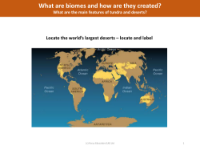Deserts - Info sheet

Turning our focus to deserts, these vast and varied landscapes are defined by receiving less than 10 inches of rainfall annually. Deserts are not just expanses of sand; their terrain can include stones, snow, and sand, showcasing a surprising diversity. Remarkably, 20% of the Earth's land surface is made up of deserts. These regions are home to many nocturnal animals, a behavioural adaptation that allows them to thrive in the harsh, arid conditions. The largest hot desert on our planet is the Sahara, a formidable expanse stretching across 12 countries in northern Africa. Meanwhile, the cold desert of Antarctica claims the title of the largest desert overall, demonstrating that deserts can be both sweltering and freezing environments.
Biomes like deserts are created through a combination of climatic factors that lead to their unique characteristics. In the context of deserts, these factors result in extremely low precipitation and specific conditions that life forms have adapted to survive. The Arabian Desert, for instance, is the second-largest hot desert on Earth and is situated in the Middle East. Understanding biomes such as deserts and tundras is essential to appreciate the main features that distinguish them, such as temperature extremes, precipitation patterns, and the specially adapted flora and fauna that inhabit these ecosystems.







